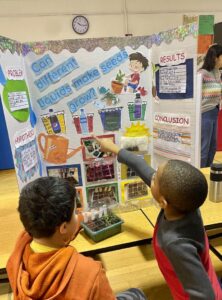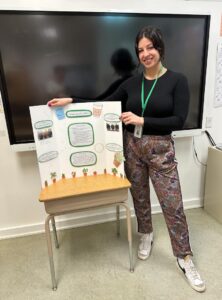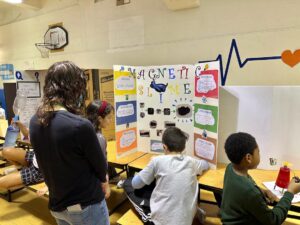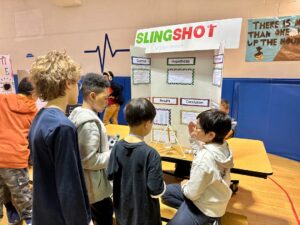Developing Young Scientists at Aaron School
Derrick Garcia, Birch Room Assistant Teacher at 45th Street
Students in Grades 4 and 5 spent the month of February conducting experiments at home to prepare for Aaron School’s Science Fair, an annual event that allows students to practice a variety of skills, including note-taking, brainstorming, problem solving, writing, creative thinking and oral presentations. Students worked on a multi-part assignment using the “Get Ready, Do, Done” model – a learning strategy used at Aaron School that helps students plan, organize and problem solve using a “backwards planning” model to complete tasks.
First, students selected a research topic that interested them, then they gathered background information from reliable sources, such as educational websites or informational print texts from our school library or local libraries in their neighborhoods. Additionally, students applied their prior knowledge to the scientific method, which involves stating the purpose of an experiment, creating a hypothesis (a prediction about the results of an experiment), describing the step-by-step process, and putting their experiments to the test.
While this assignment was largely completed at home with the help of students’ families, teachers monitored their progress and made themselves available whenever questions arose. After conducting their experiments, students documented their findings and constructed informational displays filled with scientific facts, visual aids, data, and photos of themselves hard at work.
On the day of the Science Fair, an air of excitement filled the gym as students prepared to present their projects, standing proudly next to their eye-catching displays. Most students used large tri-fold poster boards, but one student created a digital presentation that was shown on a laptop computer while another instead chose to give a live demonstration! A few students researched tornadoes but each project was different and unique, providing us with a plethora of interesting facts about them. There was a presentation simulating an earthquake using Lego blocks, an experiment that involved planting bean sprouts using different light and water conditions, and a display demonstrating how water and oil molecules do not mix, just to name a few. One student even created a potato battery that was able to light a miniature light bulb.
The Science Fair was attended by the entire school, and our young scientists enjoyed answering questions about their projects from kindergarteners and middle school students alike. Each participant received a certificate to acknowledge their hard work, creativity and dedication to science.






